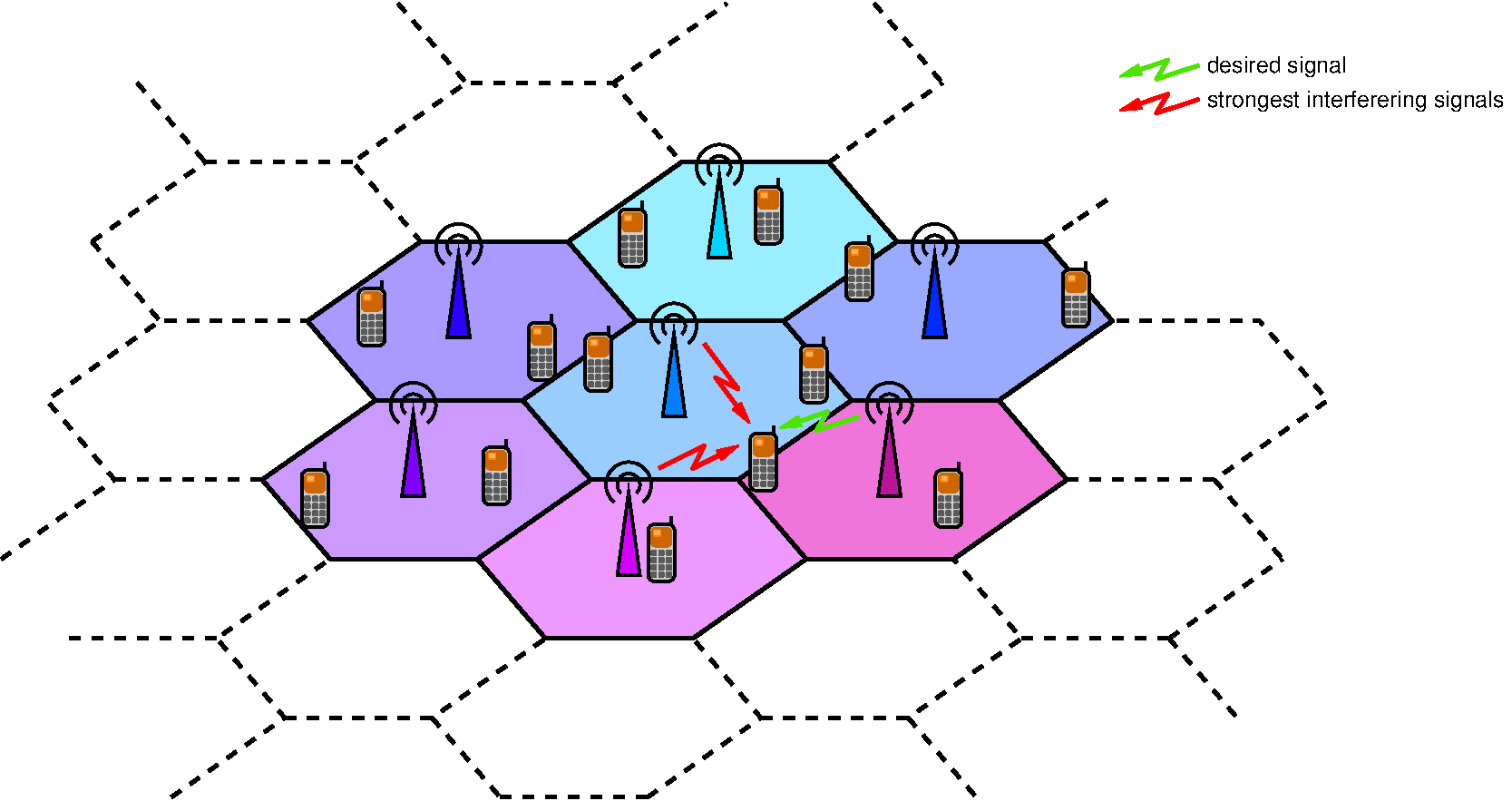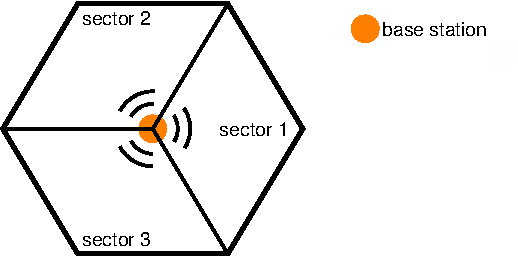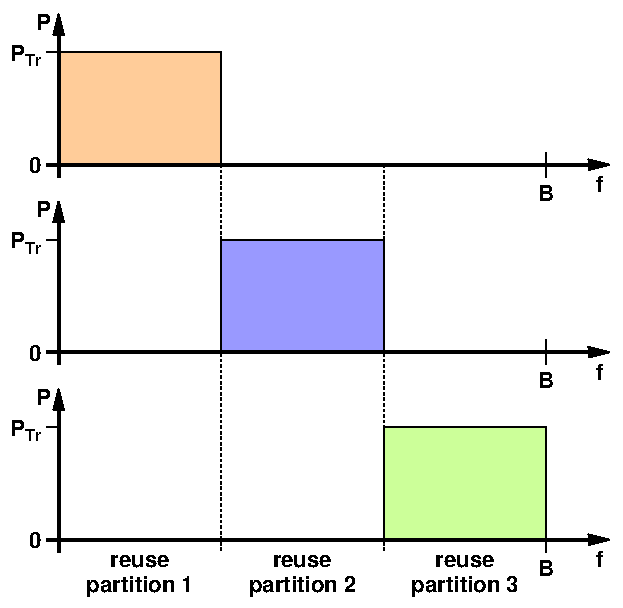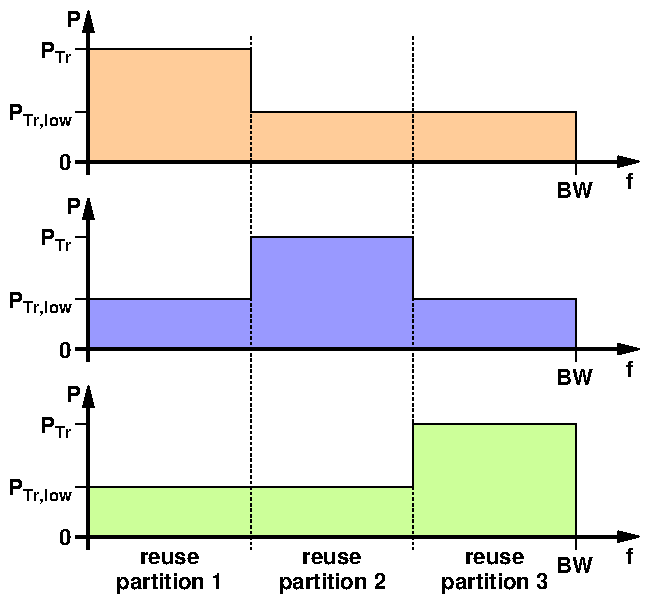
Hi there, I have spent quite a while studying intereference coordination in cellular networks.
I hope you enjoy my brief introduction on this page.
Background
Small cells of mobile networks in urban areas increase the problem of
inter-cell interference, which occurs when close-by transceivers use
the same radio resources for transmission and/or reception. This
interference may lead to severe performance degradation or connection
loss especially in the border areas of cells. GSM and WLAN networks
solve this problem by avoiding the reuse of the same frequency bands
in neighboring cells. This comes at the drawback of wasting precious
frequency resources in every cell, and hence it drastically reduces
the utilization of the scarce frequency spectrum. Instead, it is
desirable to reduce the interference by other means. A promising
approach to solve the problem of inter-cell interference is inter-cell
Interference Coordination (IFCO), where neighboring base stations or
access points coordinate their transmissions in order to minimize
interference. This can be particularly effective when combined with
beamforming antennas, which additionally allow the exploitation of
spatial multiplexing and thus the transmission to spatially separated
terminals on the same frequency/time resources.

Typical hexagonal model of a cellular network

Typical three-sectorized cell
Interference Mitigation Techniques
Frequency reuse schemes
Conventional FDMA systems combat inter-cell interference by avoiding
the reuse of the same frequency bands in adjacent cells. A certain
frequency band is therefore only used in every n-th cell.
For example, in a scenario with three cell sectors
per base station, a reuse factor of 3 is obtained by
assigning disjoint frequency bands to all three cell sectors. This
concept is also known as hard frequency reuse. The overall bandwidth is divided
into three reuse partitions, and every partition is served with a
maximum transmit power.
An increase of the frequency reuse factor commonly increases the cell
edge performance while at the same time reducing the overall spectral
efficiency. Typically,
the spectral efficiency at the cell
edge increases by a factor of two when moving from
reuse 1 to reuse 3 in a hexagonal cellular scenario with
omnidirectional antennas.

Hard Frequency Reuse

Soft Frequency Reuse
Frequency reuse schemes
In contrast to frequency reuse, which tries to avoid interference in
the first place, interference cancelation aims at removing
interference from the received signal. Two classes of co-channel
interference cancelers exist. Filter-based
approaches try to mitigate co-channel interference by means of linear
filters and interference models. In contrast, Multi-User
Detection (MUD) directly includes the interfering signals in the
decoding process. This is done by jointly decoding the signal of
interest and the interfering signals, or by decoding and subtracting
the interfering signals from the signal of interest.
The implementation of interference cancelation does not require any
modifications of the system standard, making it an attractive
technique. It has successfully been applied to both CDMA systems
and TDMA systems.
Interference randomization
Frequency reuse aims at reducing the power of the interfering
signals. Alike, interference cancelation tries to eliminate
interfering signals in the received signal. In contrast, interference
randomization, which is also known as interference whitening, tries to
make interference appear like background noise, i.e., it averages the
interference across the data symbols of a data block or the whole
frequency band. This is widely applied in CDMA systems, where
neighboring cells are separated by pseudo noise sequences. In
FDMA/TDMA systems like GSM, frequency hopping in combination with
interleaving can achieve a whitening effect. In OFDMA-based systems,
interference randomization can be achieved in a number of different
ways. First, if a frequency-diverse resource allocation is used,
different spreading patterns can be used in adjacent cells. Second,
combinations of CDMA and IDMA with OFDM have been proposed by research.
IDMA-based schemes have also been proposed within
the 3GPP LTE standardization.
Interference coordination
Interference Coordination (IFCO), also known as Inter-Cell
Interference Coordination (ICIC), has gained attention
to mitigate interference in cellular networks.
In order to reduce interference, IFCO coordinates the usage of
resources in neighboring cell sectors, either in a static, a
semi-static, or in a dynamic fashion. Resources for coordination are
space (with beamforming antennas), time slots, frequency ranges, code
resources, or transmit power. For example, in an OFDMA system, IFCO
can prevent two cell edge terminals in neighboring cell sectors to be
served on the same time/frequency resource. While the main goal is the
reduction of the interference, secondary goals determine exactly how
the interference coordination is done. Secondary goals can for
example be the maximization of the overall network capacity, or the
maximization of the cell edge throughput.
Imprint —
Terms & Conditions —
Privacy policy —
Revocation Right —
Image copyright —
Contact us
— Press and media